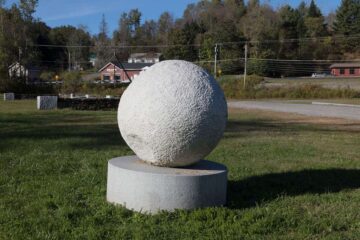Ellyn Gaydos at Harper’s Magazine:
 On a tour of Barre’s E. L. Smith quarry, one of the deepest working granite quarries in the world, Roger, a thirty-five-year veteran of the operation, led us past piles of grout to a fence. We looked over it and down into the nearly six-hundred-foot-deep hole, where the machines and their sounds, the whine of the saws and the belch of dump trucks, were more readily apparent than any human presence. The quarry was not one deep hole but a series of descending plateaus. Plants clung to the rock that gave way to penetratingly blue water that had collected in the basin, the chalky granite dust turning the pool into a false image of glacial melt. Our guide told us that in 1970, when he began working in the hole, he was one of two hundred men. Today there are only thirteen. If they were to keep going at this rate, they could continue to quarry here for the next 4,500 years. Roger told us that the company that owns the quarry will not dig any deeper—the pressure builds the farther down they go, and could begin to crack the stone—so instead they shave away at the sides of the opening. These formations were created approximately 330 million years ago, as magma from below the mantle rose and cooled. The result is uniquely uniform plugs of hard, clean-breaking Barre granite, one of the densest of carvable rocks. It bears distinct smudges of white and coal-black shavings, marred by nicks of gray and glassy dots of quartz. Combined, these minerals give the stone an indistinct solidity, as if seen through a blurred lens. Its sparkle comes from the mica exposed by a carver’s chisel.
On a tour of Barre’s E. L. Smith quarry, one of the deepest working granite quarries in the world, Roger, a thirty-five-year veteran of the operation, led us past piles of grout to a fence. We looked over it and down into the nearly six-hundred-foot-deep hole, where the machines and their sounds, the whine of the saws and the belch of dump trucks, were more readily apparent than any human presence. The quarry was not one deep hole but a series of descending plateaus. Plants clung to the rock that gave way to penetratingly blue water that had collected in the basin, the chalky granite dust turning the pool into a false image of glacial melt. Our guide told us that in 1970, when he began working in the hole, he was one of two hundred men. Today there are only thirteen. If they were to keep going at this rate, they could continue to quarry here for the next 4,500 years. Roger told us that the company that owns the quarry will not dig any deeper—the pressure builds the farther down they go, and could begin to crack the stone—so instead they shave away at the sides of the opening. These formations were created approximately 330 million years ago, as magma from below the mantle rose and cooled. The result is uniquely uniform plugs of hard, clean-breaking Barre granite, one of the densest of carvable rocks. It bears distinct smudges of white and coal-black shavings, marred by nicks of gray and glassy dots of quartz. Combined, these minerals give the stone an indistinct solidity, as if seen through a blurred lens. Its sparkle comes from the mica exposed by a carver’s chisel.
more here.
Enjoying the content on 3QD? Help keep us going by donating now.
